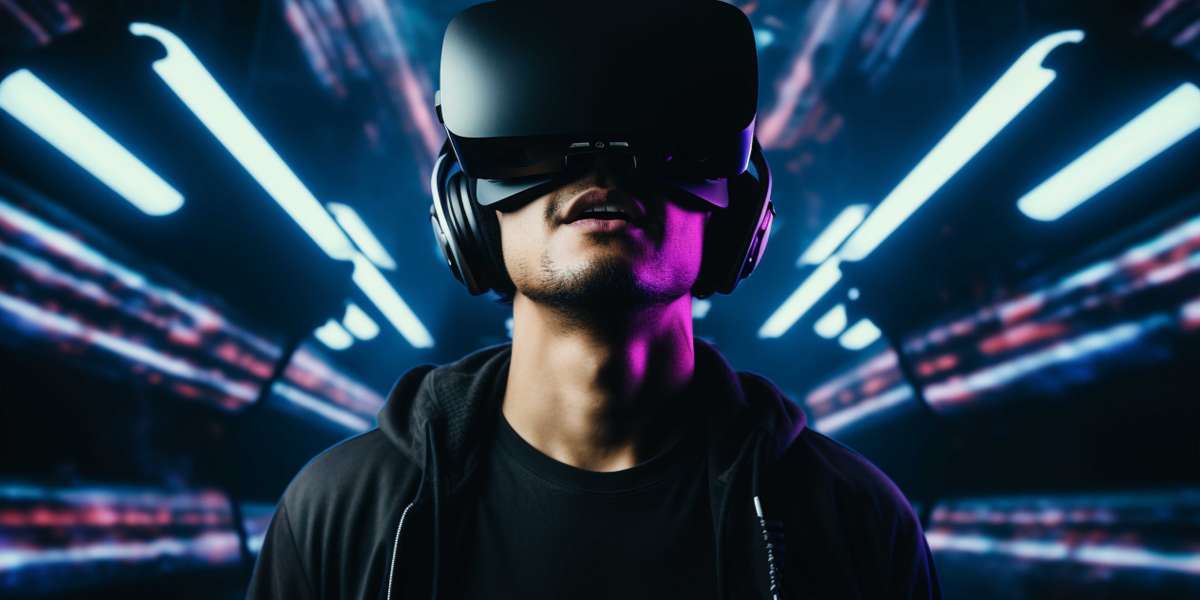Virtual Reality (VR) has transformed the gaming industry in recent years, creating immersive experiences that blur the line between digital and real worlds. What was once a dream for sci-fi enthusiasts is now a growing reality, with VR gaming taking center stage in the world of game development services. The rise of VR technology has revolutionized how games are developed, played, and experienced, providing players with unparalleled levels of interaction and engagement.
The Beginnings of Virtual Reality in Gaming
VR technology has existed in various forms for decades, but it wasn’t until the early 2010s that it became viable for mainstream gaming. The development of the Oculus Rift, one of the first consumer-grade VR headsets, marked the start of a new era in gaming. While the idea of VR had been around since the 1980s, technological limitations held it back from becoming widely accessible.
The release of the Oculus Rift in 2012 and subsequent advances in hardware made VR gaming more feasible. Game development companies began exploring the possibilities of integrating VR into their projects, allowing players to immerse themselves in digital worlds like never before.
How Virtual Reality Became Popular in Gaming
Several key factors contributed to the rapid rise of VR in gaming. First and foremost was the advancement in VR hardware. Modern headsets like the Oculus Rift, HTC Vive, and PlayStation VR allowed players to step into fully immersive environments, where they could interact with the game world using motion controllers and head-tracking technology.
Moreover, the quality of VR games improved significantly, with titles like Beat Saber, Half-Life: Alyx, and Superhot VR showcasing the potential of the platform. These games demonstrated that VR could deliver experiences far beyond traditional gaming, offering a new level of physicality and immersion.
The development of game app development for VR also played a crucial role in making the technology more accessible to a broader audience. As VR became more affordable and widespread, game developers began creating VR-exclusive content, further driving its popularity.
Why Virtual Reality Has Gained Traction
The main reason VR has gained so much popularity is the immersive experience it provides. In VR, players are no longer confined to looking at a screen—they can become part of the game itself. This deep level of immersion is what sets VR apart from traditional gaming platforms. It allows players to physically move, interact with their surroundings, and feel as though they are inside the virtual world.
Additionally, VR offers innovative gameplay mechanics. Unlike traditional gaming, where players use a controller to move their character, VR games rely on motion tracking, giving players a more intuitive and natural way to control their actions. For example, in a VR sword-fighting game, players use hand controllers to swing a virtual sword, making the experience far more interactive than pressing buttons on a controller.
The growing support from game development services has also helped to push VR forward. As more studios develop VR games and apps, the catalog of available content has grown, attracting more players to the platform. Additionally, the increasing adoption of cross-platform gaming has allowed VR users to enjoy multiplayer experiences with traditional gamers, further boosting its appeal.
Are VR Games Still Popular?
While VR has seen tremendous growth, there are still challenges to overcome. VR gaming remains a niche within the broader gaming industry, with high hardware costs and space requirements limiting its accessibility to some players. However, the demand for VR content continues to grow, and many game development companies are investing heavily in VR.
Recent trends suggest that VR is here to stay. Titles like Resident Evil Village VR, No Man’s Sky VR, and the success of VR fitness games have shown that the platform has longevity. Furthermore, the metaverse concept, which relies heavily on VR, is gaining traction, with major companies exploring virtual worlds where players can socialize, work, and play in VR environments.
VR gaming is evolving beyond just entertainment. It is being used for education, training, and even therapy, expanding its applications beyond gaming. The ability to simulate real-world scenarios makes VR a powerful tool for industries such as healthcare, military, and sports.
The Future of Virtual Reality in Gaming
The future of VR in gaming looks incredibly promising. As technology continues to advance, we can expect even more immersive experiences, with better graphics, smoother performance, and enhanced sensory feedback. Upcoming VR headsets, such as Meta's Project Cambria and the rumored Apple VR/AR headset, promise to bring even more realism to virtual environments.
One of the biggest developments on the horizon is the integration of haptic feedback and full-body motion tracking, allowing players to feel physical sensations within the game. This could enable players to experience even more tactile interactions in virtual worlds, further blurring the lines between gaming and reality.
Another key trend in the future of VR gaming is cloud-based gaming. By leveraging cloud technology, VR games could become more accessible to players who don’t own expensive hardware. This would allow users to stream VR experiences directly from servers, making high-quality VR games available on lower-end devices.
The Role of Game Development Companies in VR Gaming
As the demand for VR gaming continues to grow, game development companies play a pivotal role in driving innovation. Developers must create content that takes full advantage of the immersive capabilities of VR, ensuring that the gameplay, visuals, and mechanics are optimized for the platform.
Many game app development companies are now focusing exclusively on VR content, developing games that push the boundaries of what’s possible. From realistic simulations to fantastical worlds, VR offers an open canvas for developers to explore new ideas and create unique experiences for players.
The future will likely see more cross-platform integration, where players using VR and traditional gaming setups can seamlessly interact in the same game environment. This will enhance the social aspects of gaming and attract more players to VR platforms.
Conclusion
The rise of virtual reality in gaming has reshaped how games are developed and played, offering an immersive experience unlike any other. From its early days with the Oculus Rift to its widespread adoption today, VR gaming continues to grow in popularity. As game development services continue to innovate, the future of VR gaming looks bright, with even more exciting advancements on the horizon.
As VR technology becomes more affordable and accessible, its impact on the gaming industry will only increase. With improved hardware, more content, and the potential for new sensory experiences, virtual reality is set to remain a key player in the gaming world for years to come.
FAQs
- When did VR gaming become popular?
VR gaming started gaining traction in the early 2010s, with the release of the Oculus Rift in 2012 being a major turning point. The availability of consumer-grade VR headsets and the development of high-quality VR games like Beat Saber and Half-Life: Alyx helped cement VR gaming’s popularity. - Why has VR become so popular?
VR has become popular because it offers an unparalleled level of immersion in gaming. Players can experience worlds in a way that feels more real and interactive, using motion tracking, hand controllers, and advanced graphics to physically engage with virtual environments. The innovative gameplay and immersive experience set it apart from traditional gaming platforms. - Are VR games still popular?
Yes, VR games continue to grow in popularity, with a steady increase in new titles and innovations. While it is still a niche within the broader gaming industry, the continued development of affordable VR headsets, enhanced games, and experiences like fitness and social VR ensure that VR gaming is still thriving. - What is the future of virtual reality gaming?
The future of VR gaming includes advancements in haptic feedback, full-body tracking, and cloud gaming. Players can expect even more immersive and realistic experiences as technology improves, including more sophisticated graphics, smoother performance, and the potential for sensory feedback systems that allow players to "feel" the game. Additionally, VR is likely to expand beyond gaming into areas like social experiences, education, and workspaces.













